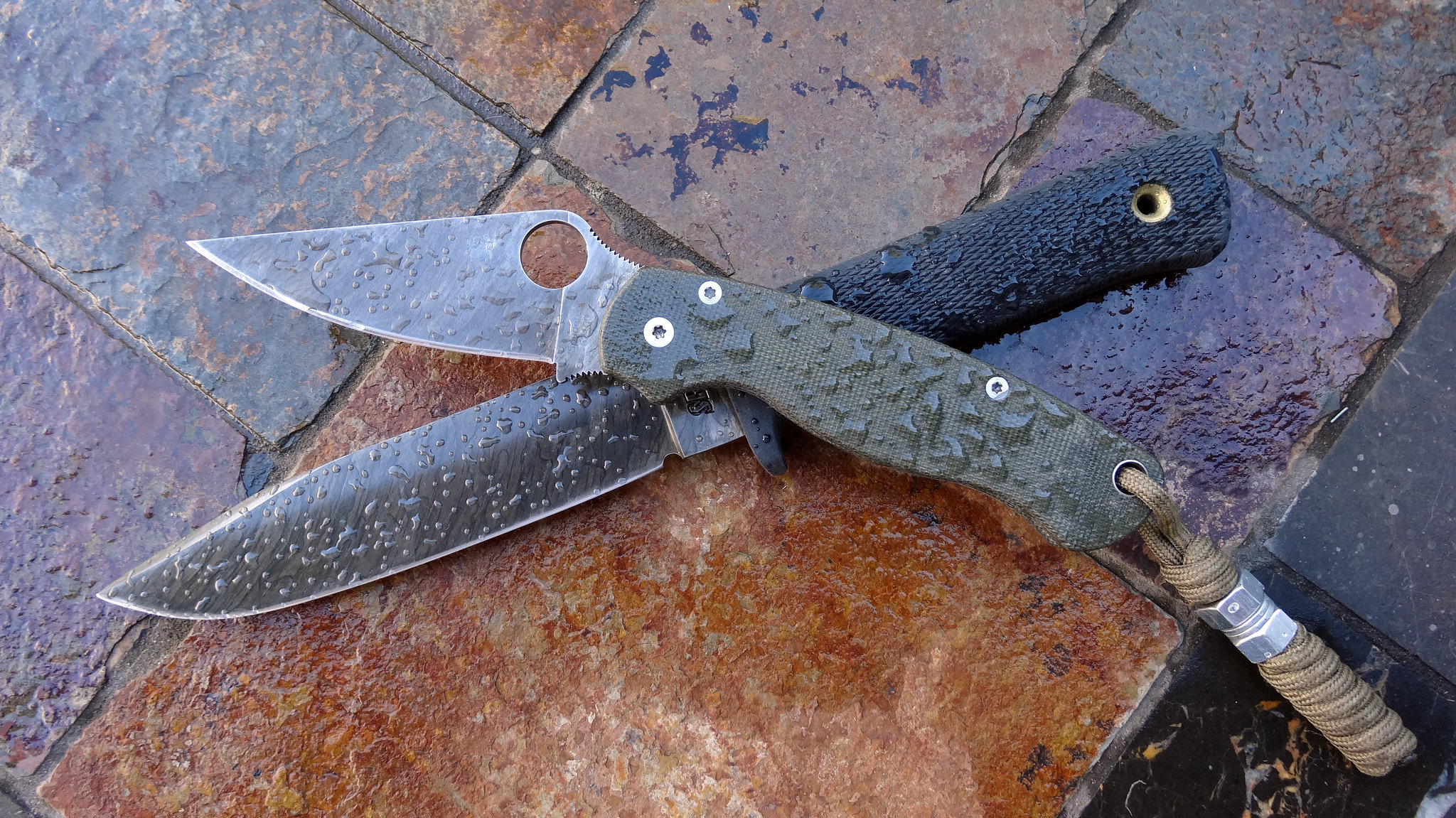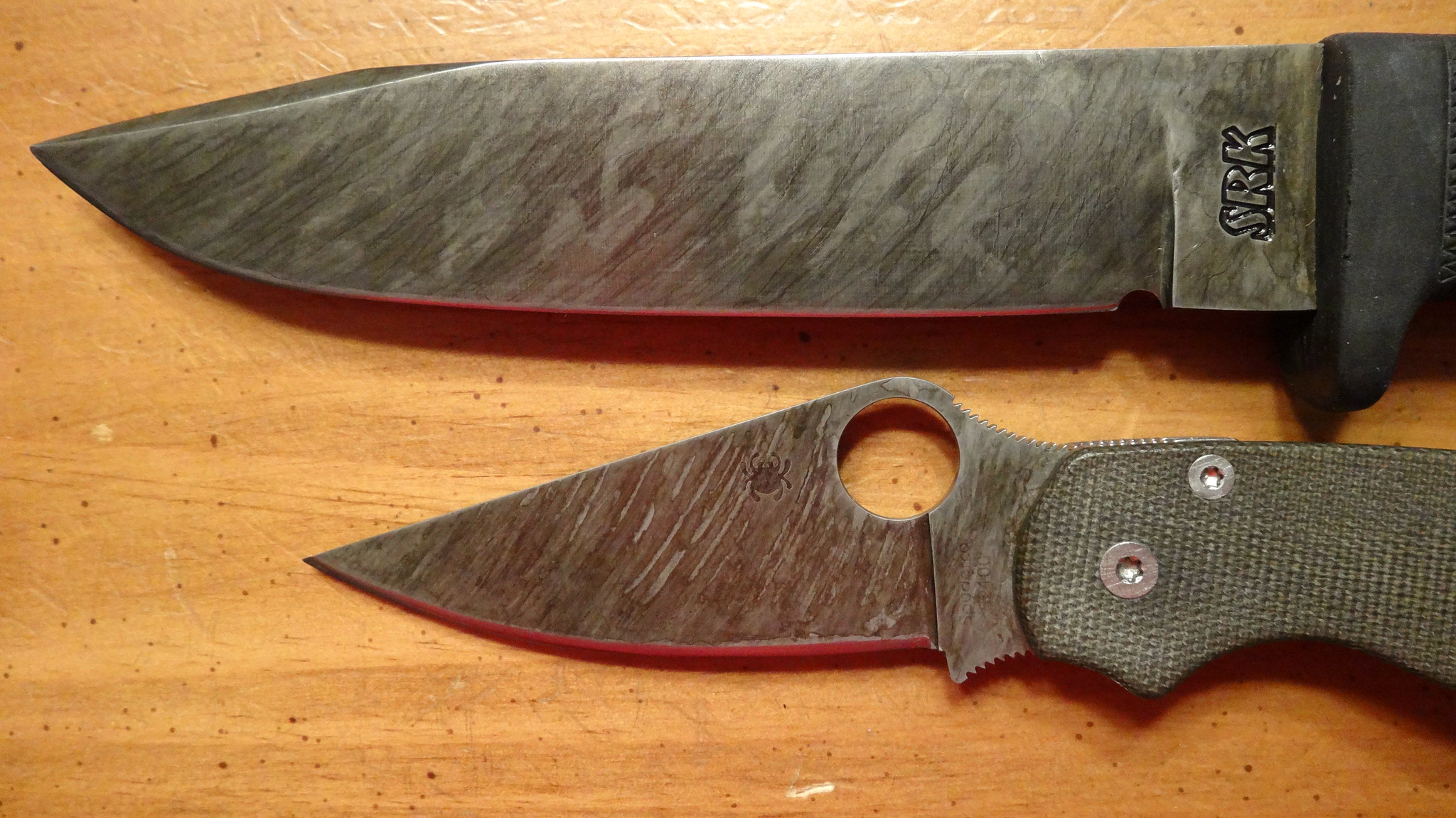on_the_edge
Gold Member
- Joined
- Jan 31, 2006
- Messages
- 11,634
A little mineral oil will go a looonnnnnnnng way. Food safe as well. 
Sweet! Enjoy the knife. My favorite offering from Spyderco is the PM2 and though a few other models get close, one of my PM2s usually is first to be carried. If you like yours, I would encourage you to consider the Maxamet version when it finally comes out. It will be a regular offering so hopefully will be around for a long time to come.on_the_edge
That clears it up, you described it perfectly. Gonna do some food prep in a bit to help that patina right along.

Picture didn't load. https://imgur.com/gallery/0k0wxI had been wiping mine down with a tuf-cloth every few days but still noticed some tiny rust spots on Friday so I decided to go ahead and force a patina.
If I wanted to do a forced patina would I have to take the knife apart to get the part inside the scales too? Is there a good tutorial on how to do this?
Thanks!
Worry NOT my friends. Your warranty is unharmed by properly servicing your knife.
https://www.spyderco.com/service-support/warranty-repair/
✓ Spyderco’s knives are assembled to exacting tolerances by trained technicians, so we discourage end users from disassembling or adjusting our knives. If a knife has been disassembled and reassembled correctly—so as to maintain its proper mechanical function—this warranty remains in full effect. However, if a knife has been disassembled and reassembled in such a way that, in Spyderco’s sole determination, the proper mechanical function of the knife has been compromised, it is no longer covered by warranty.
If you are going to apply a patina to the blade tang you should seal the face of the tang that makes contact with the PB bushings,inside the pivot hole, the detent ball track and the compression lock face. I use a Silver Sharpie. Its more like a paint than an ink and works pretty well for keeping the patina away from where you don't want it. Don't forget to soak the tang in alcohol and clean the paint off before reassembly.
I would also suggest polishing down the factory grind lines down to like a 220 grit satin. This allows your patina to coat the blade more smoothly and the reduces the roughness of the surface where red/rust can grow but leaves just enough surface texture to retain the gray, brown and black rust you want. Once you have a nice dark gray, brown and black patina, you'll need to seal the surface with oil. Massage it into the patina, just like you're spit shining shoes. You know it's coated well when your finger leaves streaks in the viscous coat without pulling oil from the blade onto your finger.
Thanks for the warranty clarification, silverds!! That sounds way more reasonable.
BTW, do you have any videos of your patina process? Aesthetically, your knife is way more pleasing to the eye.

Thank you. I don't have video but I can describe my method.
You need: acid, salt, moisture, and oxygen.
Some convenient sources for these are in your kitchen. The higher the concentrations of these ingredients the faster your patina will develop. You can use mustard, A1, vinegar, mayonnaise, pineapple juice, lime juice, lemon juice, soy sauce coffee. Use anything you want as long as it is acidic or salty or better yet, acidic and salty.
Smooth your blade. A highly polished blade won't stain as easily but is still vulnerable. Factory satin grinds are usually too aggressive and without oil, will stain easily. If you can hear a sound like running in corduroys when you scratch the blade with your fingernail, sand it down until it feels and sounds like scratching a chalkboard.. I think a 220 grit satin finish is perfect.
Wash your blade with soap. Dish soap is fine but I use soap with borax in it. I don't know why. That's what my grandfather used so that's what I use.
You can soak your blade if you are lazy or the way I do it is to completely wash the blade with your acids. Let it dry. Do it again until your blade darkens. It should darken fairly evenly, but its ok if not perfectly even, as long as the whole blade turns darker. Once you have a nice base patina. Get creative.
Mustard has different reactions depending on how it's applied, do your own testing. If you don't like what you got, clean it with a scotchbrite pad and start over.
Whatever your method, keep doing it over and over until the blade just won't take anymore. You should have dark gray, darker gray, some bronze or brown and maybe some black. Your blade will still reflect light underneath and you might still be able to see your sating finish. That's ok. If you think it's reflecting too much, rub some more stank on it.
When you're satisfied with your patina, wash it with soap. The patina should become a little lighter, but not wash off. Now season it. I've used peanut butter, olive oil, vegetable oil, bacon fat, beard oil, oil from my forehead, lard. I rub that shit in good. With a good layer of oil I either heat it with a blow dryer or over the burner on the stove until it almost too hot to touch but not hot enough to burn me. Think hot car in the sun. This thins the oil and lets it seep a little deeper. Lastly I rub the oil in deep until my finger leaves streaks in the coat without picking up oil from the blade. The blade should feel like a wax candle. That's how I do it.
My camera doesn't pick up the brown so much, I think it's because my table background overwhelms those tones but the PM2 has a "Realtree" effect. The SRK looks more like dingy urban camo. I didn't plan it that way, it's just how they turned out. The pinkish reflection is my ugly mug.

